Deck 5: Probability
Question
Question
Question
Question
Question
Question
Question
Question
Question
Question
Question
Question
Question
Question
Question
Question
Question
Question
Question
Question
Question
Question
Question
Question
Question
Question
Question
Question
Question
Question
Question
Question
Question
Question
Question
Question
Question
Question
Question
Question
Question
Question
Question
Question
Question
Question
Question
Question
Question
Question
Question
Question
Question
Question
Question
Question
Question
Question
Question
Question
Question
Question
Question
Question
Question
Question
Question
Question
Question
Question
Question
Question
Question
Question
Question
Question
Question
Question
Question
Question

Unlock Deck
Sign up to unlock the cards in this deck!
Unlock Deck
Unlock Deck
1/257
Play
Full screen (f)
Deck 5: Probability
1
A die is rolled. The set of equally likely outcomes is {1, 2, 3, 4, 5, 6}. Find the probability of getting a 5. 

A
2
Which of the following probabilities for the sample points A, B, and C could be true if A, B, and C are the onlysample points in an experiment? 

A
3
In terms of probability, a(n) ___________________ is any process with uncertain results that can be repeated.
A) Experiment
B) Sample space
C) Event
D) Outcome
A) Experiment
B) Sample space
C) Event
D) Outcome
A
4
In a 1-pond bag of skittles the possible colors were red, green, yellow, orange, and purple. The probability ofdrawing a particular color from that bag is given below. Is this a probability model?
A) Yes
B) No
A) Yes
B) No

Unlock Deck
Unlock for access to all 257 flashcards in this deck.
Unlock Deck
k this deck
5
A(n) _______________ of a probability experiment is the collection of all outcomes possible.
A) Sample space
B) Event set
C) Bernoulli space
D) Prediction set
A) Sample space
B) Event set
C) Bernoulli space
D) Prediction set

Unlock Deck
Unlock for access to all 257 flashcards in this deck.
Unlock Deck
k this deck
6
The table below represents a random sample of the number of deaths per 100 cases for a certain illness overtime. If a person infected with this illness is randomly selected from all infected people, find the probabilitythat the person lives 3-4 years after diagnosis. Express your answer as a simplified fraction and as a decimal. 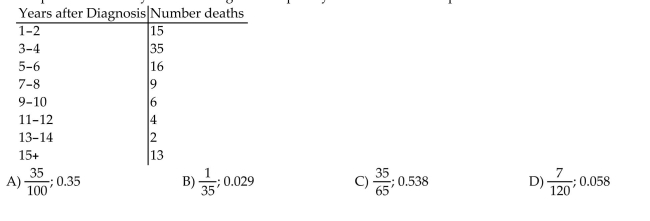


Unlock Deck
Unlock for access to all 257 flashcards in this deck.
Unlock Deck
k this deck
7
The probability that event A will occur is 


Unlock Deck
Unlock for access to all 257 flashcards in this deck.
Unlock Deck
k this deck
8
A bag contains 25 wooden beads. The colors of the beads are red, blue, white, green, black, brown, and grey.The probability of randomly selecting a bead of a particular color from the bag is given below. Is this aprobability model?
A) Yes
B) No
A) Yes
B) No

Unlock Deck
Unlock for access to all 257 flashcards in this deck.
Unlock Deck
k this deck
9
Use the spinner below to answer the question. Assume that it is equally probable that the pointer will land onany one of the five numbered spaces. If the pointer lands on a borderline, spin again.  Find the probability that the arrow will land on 5 or 4.
Find the probability that the arrow will land on 5 or 4. 
 Find the probability that the arrow will land on 5 or 4.
Find the probability that the arrow will land on 5 or 4. 

Unlock Deck
Unlock for access to all 257 flashcards in this deck.
Unlock Deck
k this deck
10
If A, B, C, and D, are the only possible outcomes of an experiment, find the probability of D using the tablebelow. 


Unlock Deck
Unlock for access to all 257 flashcards in this deck.
Unlock Deck
k this deck
11
An unusual event is an event that has a
A) Low probability of occurrence
B) Probability of 1
C) Probability which exceeds 1D)A negative probability
A) Low probability of occurrence
B) Probability of 1
C) Probability which exceeds 1D)A negative probability

Unlock Deck
Unlock for access to all 257 flashcards in this deck.
Unlock Deck
k this deck
12
Which of the following cannot be the probability of an event?
A) -59
B) 0
C) 0.001
A) -59
B) 0
C) 0.001


Unlock Deck
Unlock for access to all 257 flashcards in this deck.
Unlock Deck
k this deck
13
True or False: The probability of an event E in an empirical experiment may change from experiment toexperiment.

Unlock Deck
Unlock for access to all 257 flashcards in this deck.
Unlock Deck
k this deck
14
The probability that event A will occur is 


Unlock Deck
Unlock for access to all 257 flashcards in this deck.
Unlock Deck
k this deck
15
With which model was the greatest percentage satisfied? Estimate the empirical probability that a person withthis model is very satisfied with the experience. Express the answer as a fraction with a denominator of 100. 


Unlock Deck
Unlock for access to all 257 flashcards in this deck.
Unlock Deck
k this deck
16
You are dealt one card from a standard 52-card deck. Find the probability of being dealt an ace or a 7. 


Unlock Deck
Unlock for access to all 257 flashcards in this deck.
Unlock Deck
k this deck
17
Use the spinner below to answer the question. Assume that it is equally probable that the pointer will land onany one of the five numbered spaces. If the pointer lands on a borderline, spin again.  Find the probability that the arrow will land on an odd number.
Find the probability that the arrow will land on an odd number. 
 Find the probability that the arrow will land on an odd number.
Find the probability that the arrow will land on an odd number. 

Unlock Deck
Unlock for access to all 257 flashcards in this deck.
Unlock Deck
k this deck
18
The empirical probability that a person with a model shown is very satisfied with the experience is 10081 . Whatis the model?
A) A
B) B
C) C
D) F
A) A
B) B
C) C
D) F

Unlock Deck
Unlock for access to all 257 flashcards in this deck.
Unlock Deck
k this deck
19
Recently, the stock market took big swings up and down. A survey of 971 adult investors asked how often theytracked their portfolio. The table shows the investor responses. What is the probability that an adult investortracks his or her portfolio daily? Express your answer as a simplified fraction and as a decimal rounded tothree decimal places.  The chart below shows the percentage of people in a questionnaire who bought or leased the listed car models and werevery satisfied with the experience.
The chart below shows the percentage of people in a questionnaire who bought or leased the listed car models and werevery satisfied with the experience. 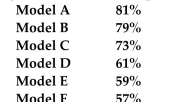
 The chart below shows the percentage of people in a questionnaire who bought or leased the listed car models and werevery satisfied with the experience.
The chart below shows the percentage of people in a questionnaire who bought or leased the listed car models and werevery satisfied with the experience. 

Unlock Deck
Unlock for access to all 257 flashcards in this deck.
Unlock Deck
k this deck
20
True or False: An outcome is any collection of events from a probability experiment.

Unlock Deck
Unlock for access to all 257 flashcards in this deck.
Unlock Deck
k this deck
21
A fair coin is tossed two times in succession. The set of equally likely outcomes is {HH, HT, TH, TT}. Find theprobability of getting the same outcome on each toss.
A) 12
B) 14
C) 34
D) 1
A) 12
B) 14
C) 34
D) 1

Unlock Deck
Unlock for access to all 257 flashcards in this deck.
Unlock Deck
k this deck
22
This problem deals with eye color, an inherited trait. For purposes of this problem, assume that only two eyecolors are possible, brown and blue. We use b to represent a blue eye gene and B a brown eye gene. If any Bgenes are present, the person will have brown eyes. The table shows the four possibilities for the children oftwo Bb (brown-eyed) parents, where each parent has one of each eye color gene.
Find the probability that these parents give birth to a child who has blue eyes.
A)
B)
C) 1
D) 0
Find the probability that these parents give birth to a child who has blue eyes.
A)
B)
C) 1
D) 0

Unlock Deck
Unlock for access to all 257 flashcards in this deck.
Unlock Deck
k this deck
23
A die is rolled. The set of equally likely outcomes is {1, 2, 3, 4, 5, 6}. Find the probability of getting a 10. 


Unlock Deck
Unlock for access to all 257 flashcards in this deck.
Unlock Deck
k this deck
24
The ______________ probability of an outcome is obtained by dividing the frequency of occurrence of an eventby the number of trials of the experiment.
A) Empirical
B) Subjective
C) Classical
D) Conditional
A) Empirical
B) Subjective
C) Classical
D) Conditional

Unlock Deck
Unlock for access to all 257 flashcards in this deck.
Unlock Deck
k this deck
25
Classify the statement as an example of classical probability, empirical probability, or subjective probability.The probability that cab fares will rise during the winter is 0.05.
A) subjective probability
B) classical probability
C) empirical probability
A) subjective probability
B) classical probability
C) empirical probability

Unlock Deck
Unlock for access to all 257 flashcards in this deck.
Unlock Deck
k this deck
26

A) Empirical
B) Classical
C) Subjective
D) Observational

Unlock Deck
Unlock for access to all 257 flashcards in this deck.
Unlock Deck
k this deck
27
A single die is rolled twice. The set of 36 equally likely outcomes is {(1,1),(1,2),(1,3),(1,4),(1,5),(1,6),(2,1) , (2,2),(2,3),(2,4),(2,5),(2,6),(3,1),(3,2),(3,3),(3,4),(3,5),(3,6),(4,1),(4,2),(4,3),(4,4),(4,5),(4,6),(5,1) , (5,2),(5,3),(5,4),(5,5),(5,6),(6,1),(6,2),(6,3),(6,4),(6,5),(6,6)} . Find the probability of getting two numbers whose sum is greater than 9 and less than 13 .
A)
B) 0
C)
D)
A)

B) 0
C)

D)


Unlock Deck
Unlock for access to all 257 flashcards in this deck.
Unlock Deck
k this deck
28
Classify the statement as an example of classical probability, empirical probability, or subjective probability.In one state lottery, a person selects a 4-digit number. The probability of winning this stateʹs lottery is 10,0001 .
A) classical probability
B) empirical probability
C) subjective probability
A) classical probability
B) empirical probability
C) subjective probability

Unlock Deck
Unlock for access to all 257 flashcards in this deck.
Unlock Deck
k this deck
29
Three fair coins are tossed in the air and land on a table. The up side of each coin is noted. How manyelements are there in the sample space?
A) 8
B) 3
C) 6
D) 4
A) 8
B) 3
C) 6
D) 4

Unlock Deck
Unlock for access to all 257 flashcards in this deck.
Unlock Deck
k this deck
30
The ______________ probability of an outcome is obtained by dividing the number of ways an event can occurby the number of possible outcomes.
A) Classical
B) Subjective
C) Empirical
D) Conditional
A) Classical
B) Subjective
C) Empirical
D) Conditional

Unlock Deck
Unlock for access to all 257 flashcards in this deck.
Unlock Deck
k this deck
31

A) Classical
B) Empirical
C) Simulated
D) Subjective

Unlock Deck
Unlock for access to all 257 flashcards in this deck.
Unlock Deck
k this deck
32
The sample space for tossing three fair coins is {HHH, HHT, HTH, HTT, THH, THT, TTH, TTT}. What is theprobability of exactly two heads? 


Unlock Deck
Unlock for access to all 257 flashcards in this deck.
Unlock Deck
k this deck
33
A probability experiment is conducted in which the sample space of the experiment is S={1,2,3,4,5,6,7,8,9,10,11,12,13,14,15} . Let event A={2,3,4,5} and event B={12,13,14} . Assume that each outcome is equally likely. List the outcomes in A and B . Are A and B mutually exclusive?
A) { }; yes
B) { }; no
C) {2,3,4,5,12,13,14} ; no
D) {2,3,4,5,12,13,14} ; yes
A) { }; yes
B) { }; no
C) {2,3,4,5,12,13,14} ; no
D) {2,3,4,5,12,13,14} ; yes

Unlock Deck
Unlock for access to all 257 flashcards in this deck.
Unlock Deck
k this deck
34
Classify the statement as an example of classical probability, empirical probability, or subjective probability.The probability that it will snow tomorrow is 53%.
A) subjective probability
B) classical probability
C) empirical probability
A) subjective probability
B) classical probability
C) empirical probability

Unlock Deck
Unlock for access to all 257 flashcards in this deck.
Unlock Deck
k this deck
35
Classify the statement as an example of classical probability, empirical probability, or subjective probability.The probability that a newborn kitten is a male 
A) classical probability
B) empirical probability
C) subjective probability

A) classical probability
B) empirical probability
C) subjective probability

Unlock Deck
Unlock for access to all 257 flashcards in this deck.
Unlock Deck
k this deck
36

A) 1
B) 0
C) 12
D) 14

Unlock Deck
Unlock for access to all 257 flashcards in this deck.
Unlock Deck
k this deck
37
You are dealt one card from a standard 52-card deck. Find the probability of being dealt a picture card. 


Unlock Deck
Unlock for access to all 257 flashcards in this deck.
Unlock Deck
k this deck
38
A single die is rolled twice. The set of 36 equally likely outcomes is [(1,1),(1,2),(1,3),(1,4),(1,5),(1,6),(2,1), ,
(2,2),(2,3),(2,4),(2,5),(2,6),(3,1),(3,2),(3,3),(3,4),(3,5),(3,6),(4,1),(4,2),(4,3),(4,4),(4,5),(4,6),(5,1) ,
(5,2),(5,3),(5,4),(5,5),(5,6),(6,1),(6,2),(6,3),(6,4),(6,5),(6,6)} . Find the probability of getting two numbers
whose sum is greater than 10 .
A)
B)
C)
D) 3
(2,2),(2,3),(2,4),(2,5),(2,6),(3,1),(3,2),(3,3),(3,4),(3,5),(3,6),(4,1),(4,2),(4,3),(4,4),(4,5),(4,6),(5,1) ,
(5,2),(5,3),(5,4),(5,5),(5,6),(6,1),(6,2),(6,3),(6,4),(6,5),(6,6)} . Find the probability of getting two numbers
whose sum is greater than 10 .
A)

B)

C)

D) 3

Unlock Deck
Unlock for access to all 257 flashcards in this deck.
Unlock Deck
k this deck
39
The ______________ probability of an outcome is a probability based on personal judgment.
A) Subjective
B) Classical
C) Empirical
D) Conditional
A) Subjective
B) Classical
C) Empirical
D) Conditional

Unlock Deck
Unlock for access to all 257 flashcards in this deck.
Unlock Deck
k this deck
40
Classify the statement as an example of classical probability, empirical probability, or subjective probability. Itis known that the probability of hitting a pothole while driving on a certain road is 1%.
A) empirical probability
B) classical probability
C) subjective probability
A) empirical probability
B) classical probability
C) subjective probability

Unlock Deck
Unlock for access to all 257 flashcards in this deck.
Unlock Deck
k this deck
41
The table lists the drinking habits of a group of college students. If a student is chosen at random, find theprobability of getting someone who is a woman or a heavy drinker. Round your answer to three decimalplaces. 
A) 0.534
B) 0.922
C) 0.805
D) 0.173

A) 0.534
B) 0.922
C) 0.805
D) 0.173

Unlock Deck
Unlock for access to all 257 flashcards in this deck.
Unlock Deck
k this deck
42
The table lists the drinking habits of a group of college students. If a student is chosen at random, find theprobability of getting someone who is a man or a non-drinker. Round your answer to three decimal places. 
A) 0.923
B) 0.947
C) 0.941
D) 0.832

A) 0.923
B) 0.947
C) 0.941
D) 0.832

Unlock Deck
Unlock for access to all 257 flashcards in this deck.
Unlock Deck
k this deck
43
A probability experiment is conducted in which the sample space of the experiment is S={1,2,3,4,5,6,7,8,9,10,11,12,13,14,15} . Let event A={7,8,9,10} and event B={9,10,11,12,13} .
Assume that each outcome is equally likely. List the outcomes in A and B. Are A and B mutually exclusive?
A) {9,10} ; no
B) {9,10} ; yes
C) {7,8,9,10,11,12,13} ; no
D) {7,8,9,10,11,12,13} ; yes
Assume that each outcome is equally likely. List the outcomes in A and B. Are A and B mutually exclusive?
A) {9,10} ; no
B) {9,10} ; yes
C) {7,8,9,10,11,12,13} ; no
D) {7,8,9,10,11,12,13} ; yes

Unlock Deck
Unlock for access to all 257 flashcards in this deck.
Unlock Deck
k this deck
44
The distribution of Bachelorʹs degrees conferred by a university is listed in the table. Assume that a studentmajors in only one subject. What is the probability that a randomly selected student with a Bachelorʹs degreemajored in Physics or Philosophy? Round your answer to three decimal places. 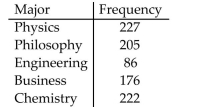
A) 0.472
B) 0.528
C) 0.248
D) 0.224

A) 0.472
B) 0.528
C) 0.248
D) 0.224

Unlock Deck
Unlock for access to all 257 flashcards in this deck.
Unlock Deck
k this deck
45
The distribution of Bachelorʹs degrees conferred by a university is listed in the table. Assume that a studentmajors in only one subject. What is the probability that a randomly selected student with a Bachelorʹs degreemajored 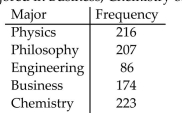 in Business, Chemistry or Engineering? Round your answer to three decimal places.
in Business, Chemistry or Engineering? Round your answer to three decimal places.
A) 0.533
B) 0.467
C) 0.287
D) 0.341
 in Business, Chemistry or Engineering? Round your answer to three decimal places.
in Business, Chemistry or Engineering? Round your answer to three decimal places.A) 0.533
B) 0.467
C) 0.287
D) 0.341

Unlock Deck
Unlock for access to all 257 flashcards in this deck.
Unlock Deck
k this deck
46
The table lists the drinking habits of a group of college students. If a student is chosen at random, find theprobability of getting someone who is a non-drinker. Round your answer to three decimal places. 
A) 0.765
B) 0.933
C) 1
D) 0.235

A) 0.765
B) 0.933
C) 1
D) 0.235

Unlock Deck
Unlock for access to all 257 flashcards in this deck.
Unlock Deck
k this deck
47
If two events have no outcomes in common they are said to be
A) Disjoint
B) Independent
C) Conditional
D) At odds
A) Disjoint
B) Independent
C) Conditional
D) At odds

Unlock Deck
Unlock for access to all 257 flashcards in this deck.
Unlock Deck
k this deck
48
A card is drawn from a standard deck of 52 playing cards. Find the probability that the card is a queen or aclub. Express the probability as a simplified fraction. 


Unlock Deck
Unlock for access to all 257 flashcards in this deck.
Unlock Deck
k this deck
49
The table below shows the probabilities generated by rolling one die 50 times and recording the number rolled.Are the events A = { roll an odd number } and B = {roll a number less than or equal to two} disjoint? 
A) No
B) Yes

A) No
B) Yes

Unlock Deck
Unlock for access to all 257 flashcards in this deck.
Unlock Deck
k this deck
50
The table lists the drinking habits of a group of college students. If a student is chosen at random, find theprobability of getting someone who is a man or a woman. Round your answer to three decimal places. 
A) 1
B) 0.930
C) 0.778
D) 0.222

A) 1
B) 0.930
C) 0.778
D) 0.222

Unlock Deck
Unlock for access to all 257 flashcards in this deck.
Unlock Deck
k this deck
51
Given that P(A or B) find P(B) . Express the probability as a simplified fraction.
find P(B) . Express the probability as a simplified fraction.
A)
B)
C)
D)
 find P(B) . Express the probability as a simplified fraction.
find P(B) . Express the probability as a simplified fraction.A)

B)

C)

D)


Unlock Deck
Unlock for access to all 257 flashcards in this deck.
Unlock Deck
k this deck
52
A probability experiment is conducted in which the sample space of the experiment is S={1,2,3,4,5,6,7,8,9,10,11,12,13,14,15} . Let event A={7,8,9,10} and event B={9,10,11,12,13} . Assume that each outcome is equally likely. List the outcomes in A or B. Find P(A or B).
A) {7,8,9,10,11,12,13} ;
B) {9,10} ;
C) {7,8,9,10,11,11,12,13} ;
D) {7,8,9,10,12,13} ;
A) {7,8,9,10,11,12,13} ;

B) {9,10} ;

C) {7,8,9,10,11,11,12,13} ;

D) {7,8,9,10,12,13} ;


Unlock Deck
Unlock for access to all 257 flashcards in this deck.
Unlock Deck
k this deck
53
In the game of craps, two dice are tossed and the up faces are totaled. Is the event getting a total of 9 and oneof the dice showing a 6 mutually exclusive?

Unlock Deck
Unlock for access to all 257 flashcards in this deck.
Unlock Deck
k this deck
54
In the game of craps two dice are rolled and the up faces are totaled. If the person rolling the dice on the firstroll rolls a 7 or an 11 total they win. If they roll a 2, 3, or 12 on the first roll they lose. If they roll any other totalthen on subsequent rolls they must roll that total before rolling a 7 to win. What is the probability of winningon the first roll?
A) 0.22
B) 0.17
C) 0.06
D) 0.50
A) 0.22
B) 0.17
C) 0.06
D) 0.50

Unlock Deck
Unlock for access to all 257 flashcards in this deck.
Unlock Deck
k this deck
55
The below table shows the probabilities generated by rolling one die 50 times and noting the up face. What isthe probability of getting an odd up face? 
A) 0.58
B) 0.42
C) 0.50
D) 0.55

A) 0.58
B) 0.42
C) 0.50
D) 0.55

Unlock Deck
Unlock for access to all 257 flashcards in this deck.
Unlock Deck
k this deck
56
True or False: Mutually exclusive events are not disjoint events.

Unlock Deck
Unlock for access to all 257 flashcards in this deck.
Unlock Deck
k this deck
57
A card is drawn from a standard deck of 52 playing cards. Find the probability that the card is a picture card. 


Unlock Deck
Unlock for access to all 257 flashcards in this deck.
Unlock Deck
k this deck
58
Using a standard deck of 52 playing cards are the events of getting an ace and getting a jack on the card drawnmutually exclusive?

Unlock Deck
Unlock for access to all 257 flashcards in this deck.
Unlock Deck
k this deck
59
One hundred people were asked, ʺDo you favor stronger laws on gun control?ʺ Of the 33 that answered ʺyesʺto the question, 14 were male. Of the 67 that answered ʺnoʺ to the question, six were male. If one person isselected at random, what is the probability that this person answered ʺyesʺ or was a male? Round the thenearest hundredth.
A) 0.39
B) 0.53
C) 0.67
D) 0.13
A) 0.39
B) 0.53
C) 0.67
D) 0.13

Unlock Deck
Unlock for access to all 257 flashcards in this deck.
Unlock Deck
k this deck
60
The table lists the drinking habits of a group of college students. If a student is chosen at random, find theprobability of getting someone who is a regular or heavy drinker. Round your answer to three decimal places. 
A) 0.179
B) 0.629
C) 0.201
D) 0.112

A) 0.179
B) 0.629
C) 0.201
D) 0.112

Unlock Deck
Unlock for access to all 257 flashcards in this deck.
Unlock Deck
k this deck
61
Fill in the blank. The of an event A is the event that A does not occur.
A) complement
B) intersection
C) union
D) Venn diagram
A) complement
B) intersection
C) union
D) Venn diagram

Unlock Deck
Unlock for access to all 257 flashcards in this deck.
Unlock Deck
k this deck
62
The breakdown of workers in a particular state according to their political affiliation and type of job held isshown here. Suppose a worker is selected at random within the state and the worker?s political affiliation andtype of job are noted. Find the probability the worker is not an Independent. Round the the nearest hundredth.
A) 0.63
B) 0.37
C) 0.29
D) 0.34
A) 0.63
B) 0.37
C) 0.29
D) 0.34

Unlock Deck
Unlock for access to all 257 flashcards in this deck.
Unlock Deck
k this deck
63
A local country club has a membership of 600 and operates facilities that include an 18-hole championship golfcourse and 12 tennis courts. Before deciding whether to accept new members, the club president would like toknow how many members regularly use each facility. A survey of the membership indicates that 61% regularlyuse the golf course, 45% regularly use the tennis courts, and 3% use neither of these facilities regularly. Whatpercentage of the 600 use at least one of the golf or tennis facilities?
A) 97%
B) 3%
C) 103%
D) 9%
A) 97%
B) 3%
C) 103%
D) 9%

Unlock Deck
Unlock for access to all 257 flashcards in this deck.
Unlock Deck
k this deck
64
The overnight shipping business has skyrocketed in the last ten years. The single greatest predictor of acompanyʹs success has been proven time and again to be customer service. A study was conducted to study thecustomer satisfaction levels for one overnight shipping business. In addition to the customerʹs satisfaction level,the customers were asked how often they used overnight shipping. The results are shown below in thefollowing table. What is the probability that a respondent did not have a high level of satisfaction with thecompany? Round the the nearest hundredth. 
A) 0.34
B) 0.66
C) 0.57
D) 0.43

A) 0.34
B) 0.66
C) 0.57
D) 0.43

Unlock Deck
Unlock for access to all 257 flashcards in this deck.
Unlock Deck
k this deck
65
If one card is drawn from a standard 52 card playing deck, determine the probability of getting a jack, a three, aclub or a diamond. Round to the nearest hundredth.
A) 0.58
B) 0.65
C) 0.50
D) 0.15
A) 0.58
B) 0.65
C) 0.50
D) 0.15

Unlock Deck
Unlock for access to all 257 flashcards in this deck.
Unlock Deck
k this deck
66
In 5-card poker, played with a standard 52-card deck, 2,598,960 different hands are possible. If there are 624different ways a ʺfour-of-a-kindʺ can be dealt, find the probability of not being dealt a ʺfour-of-a-kindʺ.Express the probability as a fraction, but do not simplify. 


Unlock Deck
Unlock for access to all 257 flashcards in this deck.
Unlock Deck
k this deck
67
A probability experiment is conducted in which the sample space of the experiment is
S={2,3,4,5,6,7,8,9,10,11,12} . Let event A={5,6,7,8,9} . Assume that each outcome is equally likely. List the outcomes in Ac . Find P(Ac) .
A) {2,3,4,10,11,12} ;
B) {5,6,7,8,9} ;
C) {10,11,12} ;
D) {2,3,4,9,10,11,12} ;
S={2,3,4,5,6,7,8,9,10,11,12} . Let event A={5,6,7,8,9} . Assume that each outcome is equally likely. List the outcomes in Ac . Find P(Ac) .
A) {2,3,4,10,11,12} ;

B) {5,6,7,8,9} ;

C) {10,11,12} ;

D) {2,3,4,9,10,11,12} ;


Unlock Deck
Unlock for access to all 257 flashcards in this deck.
Unlock Deck
k this deck
68
A sample of 220 shoppers at a large suburban mall were asked two questions: (1) Did you see a television adfor the sale at department store X during the past 2 weeks? (2) Did you shop at department store X during thepast 2 weeks? The responses to the questions are summarized in the table. What is the probability that arandomly selected shopper from the 220 questioned did not shop at department store X? Round the the nearestthousandth. 
A) 0.386
B) 0.159
C) 0.227
D) 0.614

A) 0.386
B) 0.159
C) 0.227
D) 0.614

Unlock Deck
Unlock for access to all 257 flashcards in this deck.
Unlock Deck
k this deck
69
You roll two dice and total the up faces. What is the probability of getting a total of 8 or two up faces that arethe same? Round the the nearest hundredth.
A) 0.28
B) 0.31
C) 0.33
D) 0.50
A) 0.28
B) 0.31
C) 0.33
D) 0.50

Unlock Deck
Unlock for access to all 257 flashcards in this deck.
Unlock Deck
k this deck
70
You are dealt one card from a 52-card deck. Find the probability that you are not dealt a spade. Express theprobability as a simplified fraction. 


Unlock Deck
Unlock for access to all 257 flashcards in this deck.
Unlock Deck
k this deck
71
Consider the data in the table shown which represents the marital status of males and females 18 years or olderin the United States in 2003. Determine the probability that a randomly selected U.S. resident 18 years or olderis divorced or a male? Round to the nearest hundredth.  Source: U.S. Census Bureau, Current Population reports
Source: U.S. Census Bureau, Current Population reports
A) 0.54
B) 0.58
C) 0.50
D) 0.04
 Source: U.S. Census Bureau, Current Population reports
Source: U.S. Census Bureau, Current Population reportsA) 0.54
B) 0.58
C) 0.50
D) 0.04

Unlock Deck
Unlock for access to all 257 flashcards in this deck.
Unlock Deck
k this deck
72
The below table shows the probabilities generated by rolling one die 50 times and noting the up face. What isthe probability of getting an odd up face and a two or less? Round the the nearest hundredth. 
A) 0.68
B) 0.90
C) 0.66
D) 0.32

A) 0.68
B) 0.90
C) 0.66
D) 0.32

Unlock Deck
Unlock for access to all 257 flashcards in this deck.
Unlock Deck
k this deck
73
Two dice are rolled. What is the probability of having both faces the same (doubles) or a total of 4 or 10? Roundto the nearest hundredth.
A) 0.28
B) 0.33
C) 0.06
D) 0.15
A) 0.28
B) 0.33
C) 0.06
D) 0.15

Unlock Deck
Unlock for access to all 257 flashcards in this deck.
Unlock Deck
k this deck
74
The following Venn diagram is for the six sample points possible when rolling a fair die. Let A be the eventrolling an even number and let B be the event rolling a number greater than 1. Which of the following eventsdescribes the event rolling a 1? 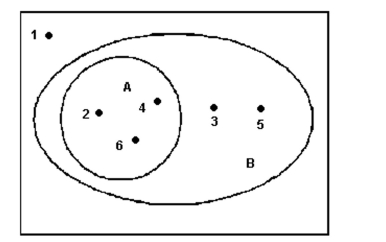
A) Bc
B) Ac
C) B
D) A ∪ B

A) Bc
B) Ac
C) B
D) A ∪ B

Unlock Deck
Unlock for access to all 257 flashcards in this deck.
Unlock Deck
k this deck
75
A certain disease only affects men 20 years of age or older. The chart shows the probability that a man with thedisease falls in the given age group. What is the probability that a randomly selected man with the disease isbetween the ages of 35 and 64? 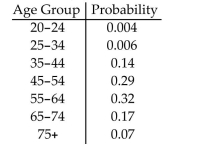
A) 0.75
B) 0.14
C) 0.32
D) 0.29

A) 0.75
B) 0.14
C) 0.32
D) 0.29

Unlock Deck
Unlock for access to all 257 flashcards in this deck.
Unlock Deck
k this deck
76
You are dealt one card from a 52-card deck. Find the probability that you are not dealt a 4. Express theprobability as a simplified fraction. 


Unlock Deck
Unlock for access to all 257 flashcards in this deck.
Unlock Deck
k this deck
77
After completing an inventory of three warehouses, a golf club shaft manufacturer described its stock of 12,246shafts with the percentages given in the table. Suppose a shaft is selected at random from the 12,246 currentlyin stock, and the warehouse number and type of shaft are observed. Find the probability that the shaft wasproduced in a warehouse other than warehouse 1. Round the the nearest hundredth. 
A) 0.70
B) 0.30
C) 0.51
D) 0.83

A) 0.70
B) 0.30
C) 0.51
D) 0.83

Unlock Deck
Unlock for access to all 257 flashcards in this deck.
Unlock Deck
k this deck
78
If one card is drawn from a standard 52 card playing deck, determine the probability of getting a ten, a king ora diamond. Round to the nearest hundredth.
A) 0.37
B) 0.40
C) 0.31
D) 0.29
A) 0.37
B) 0.40
C) 0.31
D) 0.29

Unlock Deck
Unlock for access to all 257 flashcards in this deck.
Unlock Deck
k this deck
79
True or False: P(E)+P(Ec) 1

Unlock Deck
Unlock for access to all 257 flashcards in this deck.
Unlock Deck
k this deck
80
A certain disease only affects men 20 years of age or older. The chart shows the probability that a man with thedisease falls in the given age group. What is the probability that a randomly selected man with the disease isnot between the ages of 55 and 64? 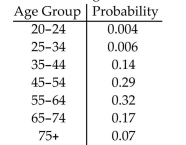
A) 0.68
B) 0.32
C) 0.29
D) 0.24

A) 0.68
B) 0.32
C) 0.29
D) 0.24

Unlock Deck
Unlock for access to all 257 flashcards in this deck.
Unlock Deck
k this deck



